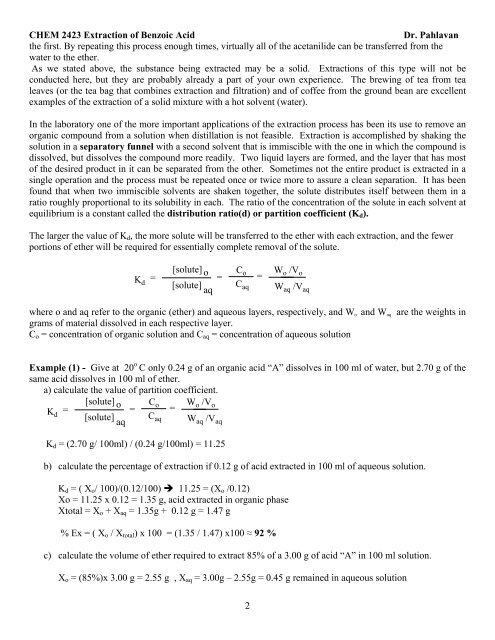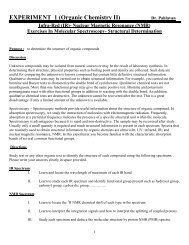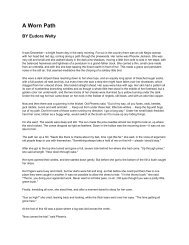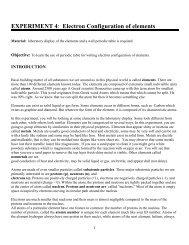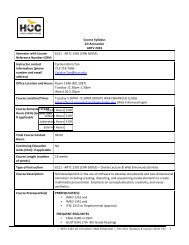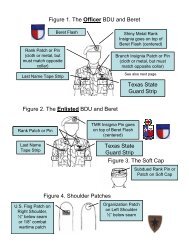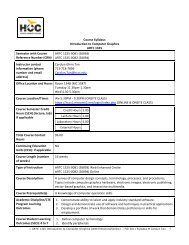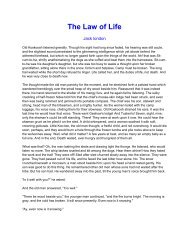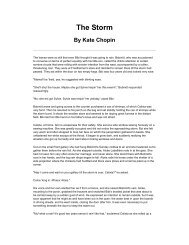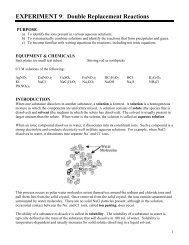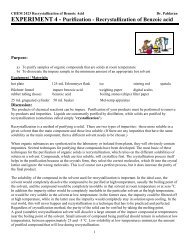EXPERIMENT 6 - Extraction
EXPERIMENT 6 - Extraction
EXPERIMENT 6 - Extraction
- No tags were found...
Create successful ePaper yourself
Turn your PDF publications into a flip-book with our unique Google optimized e-Paper software.
CHEM 2423 <strong>Extraction</strong> of Benzoic AcidDr. Pahlavanthe first. By repeating this process enough times, virtually all of the acetanilide can be transferred from thewater to the ether.As we stated above, the substance being extracted may be a solid. <strong>Extraction</strong>s of this type will not beconducted here, but they are probably already a part of your own experience. The brewing of tea from tealeaves (or the tea bag that combines extraction and filtration) and of coffee from the ground bean are excellentexamples of the extraction of a solid mixture with a hot solvent (water).In the laboratory one of the more important applications of the extraction process has been its use to remove anorganic compound from a solution when distillation is not feasible. <strong>Extraction</strong> is accomplished by shaking thesolution in a separatory funnel with a second solvent that is immiscible with the one in which the compound isdissolved, but dissolves the compound more readily. Two liquid layers are formed, and the layer that has mostof the desired product in it can be separated from the other. Sometimes not the entire product is extracted in asingle operation and the process must be repeated once or twice more to assure a clean separation. It has beenfound that when two immiscible solvents are shaken together, the solute distributes itself between them in aratio roughly proportional to its solubility in each. The ratio of the concentration of the solute in each solvent atequilibrium is a constant called the distribution ratio(d) or partition coefficient (K d ).The larger the value of K d , the more solute will be transferred to the ether with each extraction, and the fewerportions of ether will be required for essentially complete removal of the solute.K d=[solute] o[solute]aq=C oC aq=W o /V oW aq /V aqwhere o and aq refer to the organic (ether) and aqueous layers, respectively, and W o and W aq are the weights ingrams of material dissolved in each respective layer.C o = concentration of organic solution and C aq = concentration of aqueous solutionExample (1) - Give at 20 o C only 0.24 g of an organic acid “A” dissolves in 100 ml of water, but 2.70 g of thesame acid dissolves in 100 ml of ether.a) calculate the value of partition coefficient.[solute] o C o WK d== = o /V o[solute] Caq aq W aq /V aqK d = (2.70 g/ 100ml) / (0.24 g/100ml) = 11.25b) calculate the percentage of extraction if 0.12 g of acid extracted in 100 ml of aqueous solution.K d = ( X o / 100)/(0.12/100) 11.25 = (X o /0.12)Xo = 11.25 x 0.12 = 1.35 g, acid extracted in organic phaseXtotal = X o + X aq = 1.35g + 0.12 g = 1.47 g% Ex = ( X o / X total ) x 100 = (1.35 / 1.47) x100 ≈ 92 %c) calculate the volume of ether required to extract 85% of a 3.00 g of acid “A” in 100 ml solution.X o = (85%)x 3.00 g = 2.55 g , X aq = 3.00g – 2.55g = 0.45 g remained in aqueous solution2


